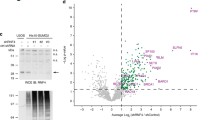Abstract
Attachment of ubiquitin or ubiquitin-like (Ubl) modifiers, such as the small ubiquitin-related modifier SUMO, is a posttranslational modification (PTM) that reversibly regulates the function and the stability of target proteins. The SUMO paralogs SUMO1 and SUMO2/3, although sharing a common conjugation pathway, seem to play different roles in the cell. Many regulatory mechanisms, which contribute to SUMO-paralog-specific modification, have emerged. We have recently found that cell environment affects SUMO-paralog-specific sumoylation of HDAC1, whose conjugation to SUMO1 and not to SUMO2 facilitates its protein turnover. Here, we describe how to identify SUMO-paralog-specific conjugation of HDAC1 and how the different expression of SUMO E3 ligases in the cell plays an important role in this mechanism.
Access this chapter
Tax calculation will be finalised at checkout
Purchases are for personal use only
Similar content being viewed by others
References
Spiegel S, Milstien S, Grant S (2012) Endogenous modulators and pharmacological inhibitors of histone deacetylases in cancer therapy. Oncogene 31:537–551
Minamiya Y, Ono T, Saito H et al (2011) Expression of histone deacetylase 1 correlates with a poor prognosis in patients with adenocarcinoma of the lung. Lung Cancer 74:300–304
Citro S, Miccolo C, Meloni L et al (2015) PI3K/mTOR mediate mitogen-dependent HDAC1 phosphorylation in breast cancer: a novel regulation of estrogen receptor expression. J Mol Cell Biol 7:132–142
Colombo R, Boggio R, Seiser C et al (2002) The adenovirus protein Gam1 interferes with sumoylation of histone deacetylase 1. EMBO Rep 3:1062–1068
Li Y, Li X, Guo B (2010) Chemopreventive agent 3,3′-diindolylmethane selectively induces proteasomal degradation of class I histone deacetylases. Cancer Res 70:646–654
Geiss-Friedlander R, Melchior F (2007) Concepts in sumoylation: a decade on. Nat Rev Mol Cell Biol 8:947–956
Geoffroy MC, Hay RT (2009) An additional role for SUMO in ubiquitin-mediated proteolysis. Nat Rev Mol Cell Biol 10:564–568
Passmore LA, Barford D (2004) Getting into position: the catalytic mechanisms of protein ubiquitylation. Biochem J 379:513–525
Rosas-Acosta G, Russell WK, Deyrieux A et al (2005) A universal strategy for proteomic studies of SUMO and other ubiquitin-like modifiers. Mol Cell Proteomics 4:56–72
Vertegaal AC, Andersen JS, Ogg SC et al (2006) Distinct and overlapping sets of SUMO-1 and SUMO-2 target proteins revealed by quantitative proteomics. Mol Cell Proteomics 5:2298–2310
David G, Neptune MA, DePinho RA (2002) SUMO-1 modification of histone deacetylase 1 (HDAC1) modulates its biological activities. J Biol Chem 277:23658–23663
Citro S, Jaffray E, Hay RT et al (2013) A role for paralog-specific sumoylation in histone deacetylase 1 stability. J Mol Cell Biol 5:416–427
Flotho A, Melchior F (2013) Sumoylation: a regulatory protein modification in health and disease. Annu Rev Biochem 82:357–385
Desterro JM, Rodriguez MS, Hay RT (1998) SUMO-1 modification of IkappaBalpha inhibits NF-kappaB activation. Mol Cell 2:233–239
Tatham MH, Jaffray E, Vaughan OA et al (2001) Polymeric chains of SUMO-2 and SUMO-3 are conjugated to protein substrates by SAE1/SAE2 and Ubc9. J Biol Chem 276:35368–35374
Acknowledgments
This work was supported by grants from Associazione Italiana per la Ricerca sul Cancro to Susanna Chiocca (AIRC IG5732, AIRC IG12075). SCi was supported by a fellowship from Fondazione Umberto Veronesi (FUV).
Author information
Authors and Affiliations
Corresponding author
Editor information
Editors and Affiliations
Rights and permissions
Copyright information
© 2017 Springer Science+Business Media New York
About this protocol
Cite this protocol
Citro, S., Chiocca, S. (2017). Assessing the Role of Paralog-Specific Sumoylation of HDAC1. In: Krämer, O. (eds) HDAC/HAT Function Assessment and Inhibitor Development. Methods in Molecular Biology, vol 1510. Humana Press, New York, NY. https://doi.org/10.1007/978-1-4939-6527-4_24
Download citation
DOI: https://doi.org/10.1007/978-1-4939-6527-4_24
Published:
Publisher Name: Humana Press, New York, NY
Print ISBN: 978-1-4939-6525-0
Online ISBN: 978-1-4939-6527-4
eBook Packages: Springer Protocols




